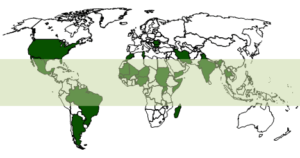
Mycetoma Belt (Source: CDC)
Mycetoma characterised by chronic granulomatous inflammatory disease, is one of the most neglected diseases. It is so neglected that estimates of incidence and prevalence are not accurate (WHO). Mycetoma caused by bacteria and fungi are termed actinomycetoma and eumycetoma, respectively. Clinically, mycetoma presents as a slow growing tumour-like structure with grains that contain the causative agent.
Evidence from a murine model of mycetoma suggests that IL-17 producing T cells, termed Th17 cells may play a role in mycetoma pathogenesis. IL-17 is a pro-inflammatory cytokine which can play a role in tissue inflammation and can indirectly contribute to neutrophil infiltration. IL-17 can also activate neutrophils to produce reactive oxygen species, which can contribute to tissue damage. IL-17 has also been shown to up-regulate matrix metalloproteases (MMPs), which play a role in tissue remodelling. MMPs but not IL-17 responses have studied in mycetoma lesions, thus Siddig et al., aimed to determine if IL-17 is also detected in mycetoma lesions.
Siddig et al., measured IL-17 and MMP-9 using immuno-histochemistry in 3 different forms of mycetoma, caused by fungus (M.mycetoma, 80%) and bacteria ( S.somaliensis, A.pellertierri 20%). They showed that IL-17A was detected in all 3 forms of mycetoma. The highest levels of IL-17 were detected in large lesions compared with smaller lesions. As expected MMP-9 was also detected in all biopsies, with higher levels of MMP-9 detected in actinomycetoma compared to eumycetoma lesions. Researchers observed a high correlation between IL-17 and MMP-9 detection in mycetoma lesions.
In summary, Siddig et al., demonstrate that IL-17 and MMP-9 may contribute to mycetoma immunopathogenesis. Further studies will be required to determine the exact role of IL-17 in mycetoma pathogenesis, and whether immuno modulation of this pathway can be utilised for immunotherapy.
Journal Article: Siddig et al., 2019. Interleukin-17 and matrix metalloprotease-9 expression in the mycetoma granuloma. Plos Pathogens.











